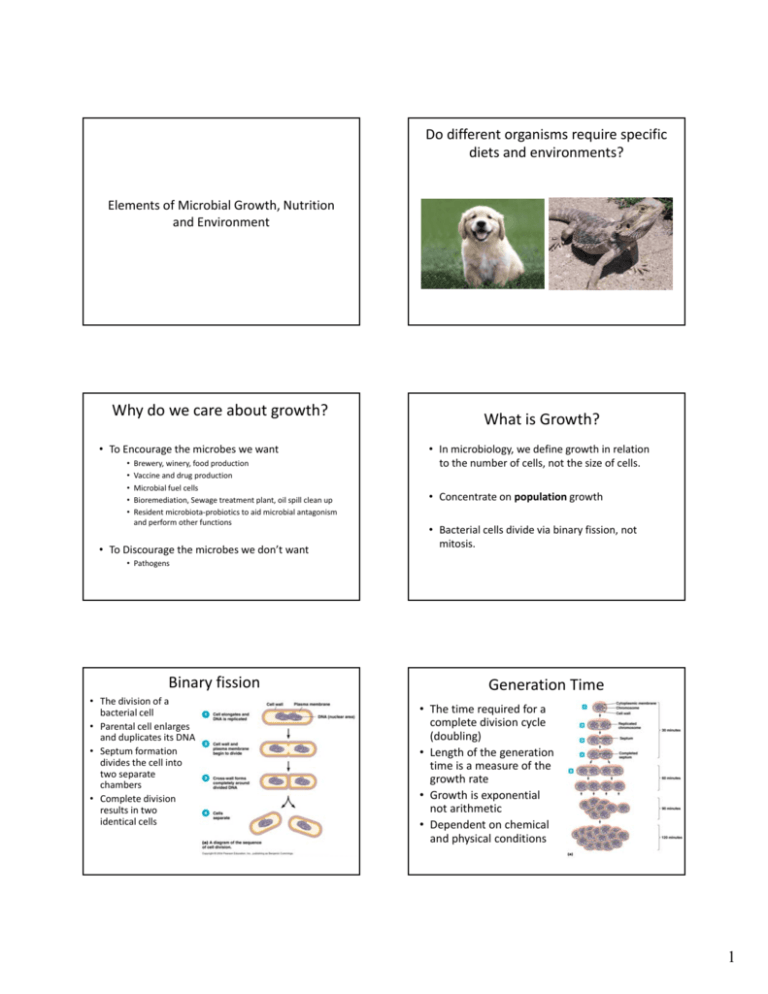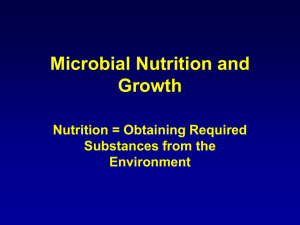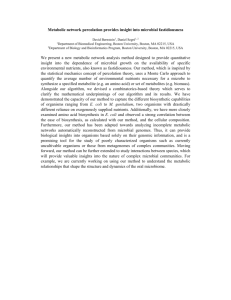Why do we care about growth? What is Growth? Binary fission
advertisement

Do different organisms require specific diets and environments? Elements of Microbial Growth, Nutrition and Environment Why do we care about growth? • To Encourage the microbes we want • • • • • Brewery, winery, food production Vaccine and drug production Microbial fuel cells Bioremediation, Sewage treatment plant, oil spill clean up Resident microbiota‐probiotics to aid microbial antagonism and perform other functions • To Discourage the microbes we don’t want What is Growth? • In microbiology, we define growth in relation to the number of cells, not the size of cells. • Concentrate on population growth • Bacterial cells divide via binary fission, not mitosis. • Pathogens Binary fission • The division of a bacterial cell • Parental cell enlarges and duplicates its DNA • Septum formation divides the cell into two separate chambers • Complete division results in two identical cells Generation Time • The time required for a complete division cycle (doubling) • Length of the generation time is a measure of the growth rate • Growth is exponential not arithmetic • Dependent on chemical and physical conditions 1 Generation Time Four phases of growth in a bacterial culture • Average generation time is 30 – 60 minutes • shortest generation times can be 10 – 12 minutes • E. coli GT=20 min. • Mycobacterium leprae has a generation time of 10 – 30 days • 11 million cells (20 generations) in 7 hours • most pathogens have relatively short generation times 1. Lag Phase • Cells are adjusting, enlarging, and synthesizing critical proteins and metabolites • Not doubling at their maximum growth rate Exponential Growth Phase • A person actively shedding bacteria in the early and middle stages of infection is more likely to spread it than a person in the later stages. Why? 2. Exponential Growth Phase (Log) • Maximum exponential growth rate of cell division • Adequate nutrients • Favorable environment • Most sensitive to antibiotics. Why? 3. Stationary Phase • Cell birth and cell death rates are equal MRSA • Survival mode – depletion in nutrients, released waste can inhibit growth 2 4. Death Phase • A majority of cells begin to die exponentially due to lack of nutrients or build up of waste • Slower than the exponential growth phase How do we measure microbial growth? • Direct measurement – Standard Plate counts • most common, need to DILUTE to get individual, countable colonies – Microscopic Count • count with microscope – Filtration • when # microbes small, • water run thru filter and filter applied to TSA plate and incubated – Coulter Counter • Automated cell counter Direct: Standard Plate Counts • Indirect (Estimation) – Turbidity – more bacteria, more cloudiness – can measure w/ spectrophotometer or eye – Metabolic Activity – assumes amount of metabolic product is proportional to # – Dry Weight – used for filamentous organisms, like molds – Genetic Probing – Real‐time PCR Direct: Microscopic Count • Advantages – Easy and fast • Disadvantages – Uses special microscope counting slide – Does not differentiate between live and dead bacteria Direct: Membrane Filtration Direct: Coulter Counter Uses an electronic sensor to detect and count the number of cells. 3 Indirect: Turbidity Using Spectrometer Indirect: Metabolism Activity • The metabolic output or input of a culture may be used to estimate viable count. • Examples: The greater the turbidity, the larger the population size. • Measure how fast gases and/or acids are formed in a culture • Or the rate a substrate such as glucose or oxygen is used up Which culture (left or right) has more bacteria? Indirect: Dry Weight Indirect: Genetic Methods • To calculate the dry weight of cells – cells must be separated from the medium – then dried – the resulting mass is then weighed • Use real‐time PCR to “count” how many bacterial genes there are in a sample. Which techniques distinguish between live and dead cells? – Standard Plate counts – Direct Microscopic – Filtration – Coulter counter – Turbidity – Metabolic activity – Dry weight – Genetic Probing Which techniques distinguish between live and dead cells? – Standard Plate counts – Direct Microscopic – Filtration – Coulter counter – Turbidity – Metabolic activity – Dry weight – Genetic Probing 4 Chemical Composition of an E. coli Cell What are the requirements for microbial growth? Microbial Nutrition Cellular Transport •Macronutrients: - carbon, hydrogen, and oxygen - required in relatively large quantities and play principal roles in cell structure and metabolism • Passive Transport – Molecules transported along concentration gradient – Does not require energy •Micronutrients: - present in much smaller amounts - manganese, zinc, nickel • Active Transport •Inorganic nutrients: - Can have carbon OR hydrogen, but not both – Molecules transported against concentration gradient – Requires energy! •Organic nutrients: - Contain a carbon‐hydrogen bond Passive Transport • Simple Diffusion – transport of small, neutral, hydrophobic molecules pass through membrane (H2O, CO2, O2) • Facilitated Diffusion – passive transport of large, charged, hydrophilic molecules – Channel Proteins – Carrier Proteins Active Transport • Carrier‐Mediated: molecules are pumped into and out of cell via protein pumps • Group Translocation: Molecules are moved across membrane and converted into useful substance simultaneously 5 Bulk Active Transport • Transport of large molecules Microbial Nutrition • All cells require the following for metabolism and growth: – Exocytosis – Endocytosis – Carbon source – Energy source • Which direction do each go? Phagocytosis‐ internalizing solid particles (ex. Bacteria) Pinocytosis‐small particles and water are brought into the cell Microbial Nutrition • Growth factors (some bacteria are fastidious/picky and require extra supplements) Microbial Nutrition •Photo and chemo is telling us information about the energy source the organism uses: •Hetero and auto is telling us information about whether the organism uses organic or inorganic sources for carbon: •Phototroph: microbes that photosynthesize •Heterotroph: Organic carbon is carbon source •Chemotroph: microbes that gain energy from ingesting and breaking down chemical compounds •Autotroph: inorganic CO2 as its carbon source - has the capacity to convert CO2 into organic compounds - not nutritionally dependent on other living things Which is most likely the category pathogens fall in? Which is most likely the category pathogens fall in? Microbial Nutrition: Autotrophs • Photoautotrophs: - Energy: Photosynthetic - Carbon source: Produce organic molecules using CO2 - Ex: Cyanobacteria, algae • Chemoautotrophs: - Energy: Ingest organic or inorganic compounds for energy - Carbon source: CO2 - Ex: Archaea bacteria Microbial Nutrition: Heterotrophs • Photoheterotrohps: - Energy: Photosynthetic - Carbon source: Organic (uses carbohydrates, fatty acids and alcohols) - Ex: Purple and green photosynthetic bacteria • Chemoheterotrophs: - Energy and Carbon source: organic compounds - The vast majority of microbes causing human disease are chemoheterotrophs - Ex: Most bacteria (that we know of), all protists, all fungi, and all animals 6 Environmental (Physical) Factors Effecting Bacterial Growth Metabolism: Building Blocks Carbon Source Energy Source Photo‐ Energy from Sun Chemo‐ Energy from chemicals Auto‐ Carbon from inorganic molecules Photoautotrophs Chemoautotrophs Hetero‐ Carbon from organic molecules Photoheterotrophs • Temperature • Gas • pH • Osmotic pressure • Other factors • Microbial association Survival in a changing environment is largely a matter of whether the enzyme systems of microorganisms can adapt to alterations in their habitat Chemoheterotrophs Environmental Factors: Temperature Temperature and Bacterial Growth • Effect of temperature on proteins: –Too high, proteins unfold and denature –Too low, do not work efficiently • Effect of temperature on membranes of cells and organelles: –Too low, membranes become rigid and fragile –Too high, membranes become too fluid Five categories of microbes based on temperature ranges for growth • Two gases that most influence microbial growth Copyright © The McGraw-Hill Companies, Inc. Permission required for reproduction or display. Minimum Maximum Psychrophile Psychrotroph Mesophile Thermophile Extreme thermophile – Oxygen Rate of Growth Optimum -20 Environmental Factors: Gases • O2 has the greatest impact on microbial growth • O2 is an important respiratory gas and a powerful oxidizing agent -10 0 10 20 30 40 50 60 70 80 90 100 110 120 Temperature °C Which category do human pathogens usually fall into? Why? 130 – Carbon dioxide • Waste for bacteria • Carbon source for others (non‐pathogens) 7 Oxygen Requirements • As oxygen enters cellular reactions, it is transformed into several toxic products – Oxygen is highly reactive and an excellent oxidizing agent (meaning it removes e‐ from molecules) •Most cells have enzymes that scavenge and neutralize reactive oxygen byproducts • Resulting oxidation causes irreparable damage to cells by attacking enzymes and proteins •Two‐step process requires two enzymes: Oxygen Requirements If bacteria do not have superoxide dismutase or catalase they can not tolerate oxygen. Oxygen Requirements •As oxygen enters cellular reactions, it is transformed into several toxic products: - singlet oxygen (O) - superoxide ion (O2‐) - hydrogen peroxide (H2O2) - hydroxyl radicals (OH‐) Catalase Test Oxygen Requirements • Obligate Aerobes • Obligate Anaerobes • Facultative anaerobes • Aerotolerant anaerobes • Microaerophiles Microaerophiles Determining Oxygen Requirements • Thioglycollate broth to demonstrate oxygen requirements. • Oxygen levels throughout the media are reduced via reaction with sodium thioglycolate. • Producing a range of oxygen levels in the media that decreases with increasing distance from the surface Oxygen Requirements: Obligate Aerobe • Requires oxygen for metabolism • Have enzymes that neutralize toxic oxygen metabolites • Ex. Most fungi, protozoa, and bacteria, such as Bacillus species and Mycobacterium tuberculosis 8 Oxygen Requirements: Obligate Anaerobes • Cannot use oxygen for metabolism • Do not possess superoxide dismutase and catalase • The presence of oxygen is toxic to the cell and will kill it • Ex. Many oral bacteria, intestinal bacteria Oxygen Requirements: Facultative Anaerobe • Does not require oxygen, but can grow in its presence • During oxygen free states, anaerobic respiration or fermentation occurs • Possess superoxide dismutase and catalase • Ex. Many Gram‐negative pathogens Prefer oxygenated environments because more energy is produced during aerobic respiration compared to anaerobic respiration or fermentation Why is this the “best” for pathogens? Oxygen Requirements: Aerotolerant • Can live with, but do not use oxygen • Able to break down peroxides (not using catylase) Oxygen Requirements: Microaerophiles • Require small amounts of oxygen • Ex. H. pylori • Ex. Some lactobacilli and streptococci Culturing Technique for Anaerobes Environmental Factors: pH • Most cells grow best between pH 6‐8 – strong acids and bases can be damaging to enzymes and other cellular substances • Pathogens like our neutral pH • Yeast & Molds like acidic conditions 9 Example of the use of a selective medium for pH Bacterial colonies Fungal colonies Environmental Factors: pH • Acidophiles – thrive in acidic environments. – Ex. Helicobacter pylori • Alkalinophiles – thrive in alkaline conditions – Ex. Proteus can create alkaline conditions to neutralize urine and colonize and infect the urinary system pH 7.3 pH 5.6 Environmental Factors: Water • Microbes require water to dissolve enzymes and nutrients • Water is an important reactant in many metabolic reactions • Most cells die in absence of water –Some have cell walls that retain water –Endospores cease most metabolic activity • Two physical effects of water –Osmotic pressure –Hydrostatic pressure: Water pressure due to gravity (depth) Other Physical Factors Influencing Microbial Growth • Radiation‐ UV, infrared • Barophiles – withstand high pressures • Spores and cysts‐ can survive dry habitats Microbes require different nutrients and different environments specific to survive. They are very specialized! Environmental Factors: Water Osmotic pressure: • Halophiles (Salt lovers) – Requires high salt concentrations – Withstands hypertonic conditions • Ex. Halobacterium • Facultative halophiles – Can survive high salt conditions but is not required – Ex. Staphylococcus aureus Associations Between Organisms – Organisms live in association with different species – Often involve nutritional interactions • Antagonistic relationships • Synergistic relationships • Symbiotic relationships Associations Between Organisms Non symbiotic Symbiotic Organisms live in close nutritional relationships; required by one or both members. Mutualism Obligatory, dependent; both members benefit. Commensalism The commensal benefits; other member not harmed. Parasitism Parasite is dependent and benefits; host harmed. Organisms are free-living; relationships not required for survival. Synergism Members cooperate and share nutrients. Antagonism Some members are inhibited or destroyed by others. 10 Associations Between Organisms •Antagonism: free‐living species compete -Antibiosis: the production of inhibitory compounds such as antibiotics -The first microbe has a competitive advantage by increasing the space and nutrients available to the competitor -Remember importance of microflora?! Associations Between Organisms • Synergism: free‐living species benefits together but is not necessary for survival • Together the participants cooperate to produce a result that none of them could do alone A biocontrol agent on the right (a bacteria) is making a material that is keeping the pathogen on the left (a fungus) from growing. Associations and Biofilms • Complex relationships among numerous species of microorganisms • Many microorganisms more harmful as part of a biofilm • Quorum sensing: used by bacteria to interact with members of the same species as well as members of other species that are close by Plaque (biofilm) on a human tooth • Gum disease, dental caries, and some bloodstream infections involve mixed infections of bacteria interacting synergistically Associations and Biofilms •Benefits of biofilm – large, complex communities form with different physical and biological characteristics – the bottom may have very different pH and oxygen conditions than the surface – partnership among multiple microbial species – cannot be eradicated by traditional methods 11








